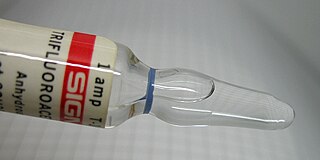Loading AI tools
One of the lightest perfluoro compounds From Wikipedia, the free encyclopedia
Trifluoroacetic acid (TFA) is a synthetic organofluorine compound with the chemical formula CF3CO2H. It is a haloacetic acid, with all three of the acetyl group's hydrogen atoms replaced by fluorine atoms. It is a colorless liquid with a vinegar-like odor. TFA is a stronger acid than acetic acid, having an acid ionisation constant, Ka, that is approximately 34,000 times higher,[3] as the highly electronegative fluorine atoms and consequent electron-withdrawing nature of the trifluoromethyl group weakens the oxygen-hydrogen bond (allowing for greater acidity) and stabilises the anionic conjugate base. TFA is commonly used in organic chemistry for various purposes.
| |||
 | |||
 | |||
| Names | |||
|---|---|---|---|
| Preferred IUPAC name
Trifluoroacetic acid | |||
| Other names
2,2,2-Trifluoroacetic acid 2,2,2-Trifluoroethanoic acid Perfluoroacetic acid Trifluoroethanoic acid TFA | |||
| Identifiers | |||
3D model (JSmol) |
|||
| 742035 | |||
| ChEBI | |||
| ChEMBL | |||
| ChemSpider | |||
| ECHA InfoCard | 100.000.846 | ||
| 2729 | |||
PubChem CID |
|||
| RTECS number |
| ||
| UNII | |||
CompTox Dashboard (EPA) |
|||
| |||
| |||
| Properties | |||
| C2HF3O2 | |||
| Molar mass | 114.023 g·mol−1 | ||
| Appearance | colorless liquid | ||
| Odor | Pungent/Vinegar | ||
| Density | 1.489 g/cm3, 20 °C | ||
| Melting point | −15.4 °C (4.3 °F; 257.8 K) | ||
| Boiling point | 72.4 °C (162.3 °F; 345.5 K) | ||
| miscible | |||
| Vapor pressure | 0.0117 bar (1.17 kPa) at 20 °C[1] | ||
| Acidity (pKa) | 0.52 [2] | ||
| Conjugate base | trifluoroacetate | ||
| -43.3·10−6 cm3/mol | |||
| Hazards | |||
| Occupational safety and health (OHS/OSH): | |||
Main hazards |
Highly corrosive | ||
| GHS labelling: | |||
  | |||
| Danger | |||
| H314, H332, H412 | |||
| P260, P261, P264, P271, P273, P280, P301+P330+P331, P303+P361+P353, P304+P312, P304+P340, P305+P351+P338, P310, P312, P321, P363, P405, P501 | |||
| NFPA 704 (fire diamond) | |||
| Safety data sheet (SDS) | External MSDS | ||
| Related compounds | |||
Related perfluorinated acids |
Heptafluorobutyric acid Perfluorooctanoic acid Perfluorononanoic acid | ||
Related compounds |
Acetic acid Trichloroacetic acid | ||
Except where otherwise noted, data are given for materials in their standard state (at 25 °C [77 °F], 100 kPa).
| |||
TFA is prepared industrially by the electrofluorination of acetyl chloride or acetic anhydride, followed by hydrolysis of the resulting trifluoroacetyl fluoride:[4]
Where desired, this compound may be dried by addition of trifluoroacetic anhydride.[5]
An older route to TFA proceeds via the oxidation of 1,1,1-trifluoro-2,3,3-trichloropropene with potassium permanganate. The trifluorotrichloropropene can be prepared by Swarts fluorination of hexachloropropene.[6]

TFA is the precursor to many other fluorinated compounds such as trifluoroacetic anhydride, trifluoroperacetic acid, and 2,2,2-trifluoroethanol.[4] It is a reagent used in organic synthesis because of a combination of convenient properties: volatility, solubility in organic solvents, and its strength as an acid.[7] TFA is also less oxidizing than sulfuric acid but more readily available in anhydrous form than many other acids. One complication to its use is that TFA forms an azeotrope with water (b. p. 105 °C).
TFA is used as a strong acid to remove protecting groups such as Boc used in organic chemistry and peptide synthesis.[8][9]
At a low concentration, TFA is used as an ion pairing agent in liquid chromatography (HPLC) of organic compounds, particularly peptides and small proteins. TFA is a versatile solvent for NMR spectroscopy (for materials stable in acid). It is also used as a calibrant in mass spectrometry.[10]
TFA is used to produce trifluoroacetate salts.[11]
Trifluoroacetic acid is a strong acid.[12] TFA is harmful when inhaled, causes severe skin burns and is toxic for aquatic organisms even at low concentrations.
Although trifluoroacetic acid is not produced biologically or abiotically,[13] it is a metabolic breakdown product of the volatile anesthetic agent halothane. It is also thought to be responsible for halothane-induced hepatitis.[14] It also may be formed by photooxidation of the commonly used refrigerant 1,1,1,2-tetrafluoroethane (R-134a).[citation needed] Moreover, it is formed as an atmospheric degradation product of almost all fourth-generation synthetic refrigerants, also called hydrofluoroolefins (HFO), such as 2,3,3,3-tetrafluoropropene.[15][16]
Trifluoroacetic acid degrades very slowly in the environment and has been found in increasing amounts as a contaminant in water, soil, food, and the human body.[17] Median concentrations of a few micrograms per liter have been found in beer and tea.[18] Seawater can contain about 200 ng of TFA per liter.[19][20][21] Biotransformation by decarboxylation to fluoroform has been discussed.[22]
Trifluoroacetic acid is mildly phytotoxic.[23]
Seamless Wikipedia browsing. On steroids.
Every time you click a link to Wikipedia, Wiktionary or Wikiquote in your browser's search results, it will show the modern Wikiwand interface.
Wikiwand extension is a five stars, simple, with minimum permission required to keep your browsing private, safe and transparent.